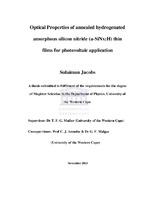| dc.description.abstract | Technological advancement has created a market for large area electronics such as
solar cells and thin film transistors (TFT’s). Such devices now play an important
role in modern society. Various types of conducting, semiconducting and insulating thin films of the order of hundreds, or even tens of nanometres are combined in strata to form stacks to create interactions and phenomena that can be exploited and employed in these devices for the benefit of mankind. One such is for the generation of energy via photovoltaic devices that use thin film technology; these are known as second and third generation solar cells. Silicon and its alloys such as silicon germanium (SiGex), silicon oxide (SiOx), silicon carbide (SiCx) and silicon nitride (SiNx) play an important role in these devices due to the fact that each material in its different structures, whether amorphous, micro or nano-crystalline or completely crystalline, has its own range of unique optical, mechanical and electrical properties. These structures and their material properties can thus exert a huge influence over the overall device performance. viii Chemical vapour deposition (CVD) techniques are most widely used in industry to obtain thin films of silicon and silicon alloys. Source gases are decomposed by the external provision of energy thereby allowing for the growth of a thin solid film on a substrate. In this study a variant of CVD, namely Hot Wire Chemical Vapour Deposition (HWCVD) will be used to deposit thin films of silicon nitride by the decomposition of silane (SiH4), hydrogen (H2) and ammonia (NH3) on a hot tantalum filament (~1600 C). Hydrogenated amorphous silicon nitride (a-SiNx:H) has great potential for application in optoelectronic devices. In commercial solar cell production its potential for use as anti-reflection coatings are due to its intermediate refractive index combined with low light absorption. An additional benefit is the passivation of interface and crystal defects due to the bonded hydrogen. This can lead to better photon conversion efficiency. Its optical properties including optical band gap, Urbach tail, and wavelength-dependent optical constants such as absorption coefficient and refractive index are crucial for the design and application in the relevant optoelectronic device. The final firing step in the production of micro-crystalline silicon solar cells, allows hydrogen to effuse into the solar cell from the a-SiNx:H, and drives bulk passivation of the grain boundaries. We therefore propose the exploration of annealing effects on the thin film structure. The study undertakes a comparison of optical and bonding structure of the as deposited thin film compared to that of the annealed thin film which would have undergone changes due to high temperature annealing under vacuum. However, it is difficult to simultaneously obtain all of these important ix optical parameters for a-SiNx:H thin films. Ultraviolet visible (UV-vis) spectroscopy will be the method of choice to investigate the optical properties. Infrared (IR) spectroscopy is a source of useful information on the microstructure of the material. In particular, the local atomic bonding configurations involving Si, N, and H atoms in a-SiNx:H films can be obtained by Fourier Transform Infrared Spectroscopy (FTIR). Therefore, this study will attempt to establish a relationship between film microstructure of a-SiNx:H thin films and their macroscopic optical properties. | en_US |

